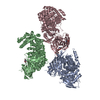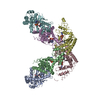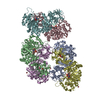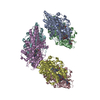[English] 日本語
 Yorodumi
Yorodumi- EMDB-20572: Cryo-EM structure of extracellular dimeric complex of RET/GFRAL/GDF15 -
+ Open data
Open data
- Basic information
Basic information
| Entry | Database: EMDB / ID: EMD-20572 | |||||||||
|---|---|---|---|---|---|---|---|---|---|---|
| Title | Cryo-EM structure of extracellular dimeric complex of RET/GFRAL/GDF15 | |||||||||
 Map data Map data | Cryo-EM map of the extracellular complex of RET/GFRAL/GDF15. C2 symmetry was applied in the 3D refinement. | |||||||||
 Sample Sample |
| |||||||||
 Keywords Keywords | RET / receptor tyrosine kinase / cryo-EM / SIGNALING PROTEIN | |||||||||
| Function / homology |  Function and homology information Function and homology informationresponse to metformin / negative regulation of growth hormone receptor signaling pathway / glial cell-derived neurotrophic factor receptor activity / reduction of food intake in response to dietary excess / Peyer's patch morphogenesis / GDF15-GFRAL signaling pathway / positive regulation of metanephric glomerulus development / ureter maturation / embryonic epithelial tube formation / glial cell-derived neurotrophic factor receptor signaling pathway ...response to metformin / negative regulation of growth hormone receptor signaling pathway / glial cell-derived neurotrophic factor receptor activity / reduction of food intake in response to dietary excess / Peyer's patch morphogenesis / GDF15-GFRAL signaling pathway / positive regulation of metanephric glomerulus development / ureter maturation / embryonic epithelial tube formation / glial cell-derived neurotrophic factor receptor signaling pathway / lymphocyte migration into lymphoid organs / posterior midgut development / Formation of the ureteric bud / membrane protein proteolysis / negative regulation of leukocyte migration / Formation of the nephric duct / enteric nervous system development / neuron cell-cell adhesion / negative regulation of appetite / positive regulation of fatty acid oxidation / plasma membrane protein complex / neuron maturation / cellular response to chemical stress / positive regulation of extrinsic apoptotic signaling pathway in absence of ligand / stress-activated protein kinase signaling cascade / positive regulation of cell adhesion mediated by integrin / neural crest cell migration / ureteric bud development / negative regulation of multicellular organism growth / positive regulation of myoblast fusion / regulation of axonogenesis / response to pain / homophilic cell-cell adhesion / negative regulation of SMAD protein signal transduction / RET signaling / positive regulation of cell size / negative regulation of extrinsic apoptotic signaling pathway in absence of ligand / regulation of cell adhesion / cellular response to retinoic acid / NPAS4 regulates expression of target genes / transmembrane receptor protein tyrosine kinase activity / transforming growth factor beta receptor signaling pathway / axon guidance / cell surface receptor protein tyrosine kinase signaling pathway / cytokine activity / growth factor activity / negative regulation of transforming growth factor beta receptor signaling pathway / positive regulation of neuron projection development / receptor protein-tyrosine kinase / hormone activity / receptor tyrosine kinase binding / nervous system development / cell-cell signaling / signaling receptor activity / MAPK cascade / actin cytoskeleton / RAF/MAP kinase cascade / protein tyrosine kinase activity / negative regulation of neuron apoptotic process / positive regulation of phosphatidylinositol 3-kinase/protein kinase B signal transduction / receptor complex / positive regulation of MAPK cascade / endosome membrane / positive regulation of cell migration / axon / external side of plasma membrane / focal adhesion / calcium ion binding / positive regulation of gene expression / positive regulation of DNA-templated transcription / Golgi apparatus / signal transduction / protein homodimerization activity / extracellular space / extracellular exosome / extracellular region / nucleoplasm / ATP binding / nucleus / plasma membrane / cytoplasm Similarity search - Function | |||||||||
| Biological species |  Homo sapiens (human) Homo sapiens (human) | |||||||||
| Method | single particle reconstruction / cryo EM / Resolution: 4.1 Å | |||||||||
 Authors Authors | Li J / Shang GJ | |||||||||
 Citation Citation |  Journal: Elife / Year: 2019 Journal: Elife / Year: 2019Title: Cryo-EM analyses reveal the common mechanism and diversification in the activation of RET by different ligands. Authors: Jie Li / Guijun Shang / Yu-Ju Chen / Chad A Brautigam / Jen Liou / Xuewu Zhang / Xiao-Chen Bai /  Abstract: RET is a receptor tyrosine kinase (RTK) that plays essential roles in development and has been implicated in several human diseases. Different from most of RTKs, RET requires not only its cognate ...RET is a receptor tyrosine kinase (RTK) that plays essential roles in development and has been implicated in several human diseases. Different from most of RTKs, RET requires not only its cognate ligands but also co-receptors for activation, the mechanisms of which remain unclear due to lack of high-resolution structures of the ligand/co-receptor/receptor complexes. Here, we report cryo-EM structures of the extracellular region ternary complexes of GDF15/GFRAL/RET, GDNF/GFRα1/RET, NRTN/GFRα2/RET and ARTN/GFRα3/RET. These structures reveal that all the four ligand/co-receptor pairs, while using different atomic interactions, induce a specific dimerization mode of RET that is poised to bring the two kinase domains into close proximity for cross-phosphorylation. The NRTN/GFRα2/RET dimeric complex further pack into a tetrameric assembly, which is shown by our cell-based assays to regulate the endocytosis of RET. Our analyses therefore reveal both the common mechanism and diversification in the activation of RET by different ligands. | |||||||||
| History |
|
- Structure visualization
Structure visualization
| Movie |
 Movie viewer Movie viewer |
|---|---|
| Structure viewer | EM map:  SurfView SurfView Molmil Molmil Jmol/JSmol Jmol/JSmol |
| Supplemental images |
- Downloads & links
Downloads & links
-EMDB archive
| Map data |  emd_20572.map.gz emd_20572.map.gz | 49.4 MB |  EMDB map data format EMDB map data format | |
|---|---|---|---|---|
| Header (meta data) |  emd-20572-v30.xml emd-20572-v30.xml emd-20572.xml emd-20572.xml | 15.9 KB 15.9 KB | Display Display |  EMDB header EMDB header |
| Images |  emd_20572.png emd_20572.png | 249.5 KB | ||
| Filedesc metadata |  emd-20572.cif.gz emd-20572.cif.gz | 6.5 KB | ||
| Archive directory |  http://ftp.pdbj.org/pub/emdb/structures/EMD-20572 http://ftp.pdbj.org/pub/emdb/structures/EMD-20572 ftp://ftp.pdbj.org/pub/emdb/structures/EMD-20572 ftp://ftp.pdbj.org/pub/emdb/structures/EMD-20572 | HTTPS FTP |
-Validation report
| Summary document |  emd_20572_validation.pdf.gz emd_20572_validation.pdf.gz | 533.4 KB | Display |  EMDB validaton report EMDB validaton report |
|---|---|---|---|---|
| Full document |  emd_20572_full_validation.pdf.gz emd_20572_full_validation.pdf.gz | 532.9 KB | Display | |
| Data in XML |  emd_20572_validation.xml.gz emd_20572_validation.xml.gz | 5.8 KB | Display | |
| Data in CIF |  emd_20572_validation.cif.gz emd_20572_validation.cif.gz | 6.7 KB | Display | |
| Arichive directory |  https://ftp.pdbj.org/pub/emdb/validation_reports/EMD-20572 https://ftp.pdbj.org/pub/emdb/validation_reports/EMD-20572 ftp://ftp.pdbj.org/pub/emdb/validation_reports/EMD-20572 ftp://ftp.pdbj.org/pub/emdb/validation_reports/EMD-20572 | HTTPS FTP |
-Related structure data
| Related structure data |  6q2jMC  6q2nC  6q2oC  6q2rC  6q2sC M: atomic model generated by this map C: citing same article ( |
|---|---|
| Similar structure data |
- Links
Links
| EMDB pages |  EMDB (EBI/PDBe) / EMDB (EBI/PDBe) /  EMDataResource EMDataResource |
|---|---|
| Related items in Molecule of the Month |
- Map
Map
| File |  Download / File: emd_20572.map.gz / Format: CCP4 / Size: 52.7 MB / Type: IMAGE STORED AS FLOATING POINT NUMBER (4 BYTES) Download / File: emd_20572.map.gz / Format: CCP4 / Size: 52.7 MB / Type: IMAGE STORED AS FLOATING POINT NUMBER (4 BYTES) | ||||||||||||||||||||||||||||||||||||||||||||||||||||||||||||||||||||
|---|---|---|---|---|---|---|---|---|---|---|---|---|---|---|---|---|---|---|---|---|---|---|---|---|---|---|---|---|---|---|---|---|---|---|---|---|---|---|---|---|---|---|---|---|---|---|---|---|---|---|---|---|---|---|---|---|---|---|---|---|---|---|---|---|---|---|---|---|---|
| Annotation | Cryo-EM map of the extracellular complex of RET/GFRAL/GDF15. C2 symmetry was applied in the 3D refinement. | ||||||||||||||||||||||||||||||||||||||||||||||||||||||||||||||||||||
| Projections & slices | Image control
Images are generated by Spider. | ||||||||||||||||||||||||||||||||||||||||||||||||||||||||||||||||||||
| Voxel size | X=Y=Z: 1.07 Å | ||||||||||||||||||||||||||||||||||||||||||||||||||||||||||||||||||||
| Density |
| ||||||||||||||||||||||||||||||||||||||||||||||||||||||||||||||||||||
| Symmetry | Space group: 1 | ||||||||||||||||||||||||||||||||||||||||||||||||||||||||||||||||||||
| Details | EMDB XML:
CCP4 map header:
| ||||||||||||||||||||||||||||||||||||||||||||||||||||||||||||||||||||
-Supplemental data
- Sample components
Sample components
-Entire : RET, GFRAL and GDF15 extracellular complex
| Entire | Name: RET, GFRAL and GDF15 extracellular complex |
|---|---|
| Components |
|
-Supramolecule #1: RET, GFRAL and GDF15 extracellular complex
| Supramolecule | Name: RET, GFRAL and GDF15 extracellular complex / type: complex / ID: 1 / Parent: 0 / Macromolecule list: #1-#3 |
|---|---|
| Source (natural) | Organism:  Homo sapiens (human) Homo sapiens (human) |
| Molecular weight | Theoretical: 200 kDa/nm |
-Macromolecule #1: Growth/differentiation factor 15
| Macromolecule | Name: Growth/differentiation factor 15 / type: protein_or_peptide / ID: 1 / Number of copies: 2 / Enantiomer: LEVO |
|---|---|
| Source (natural) | Organism:  Homo sapiens (human) Homo sapiens (human) |
| Molecular weight | Theoretical: 14.879113 KDa |
| Recombinant expression | Organism:  |
| Sequence | String: MGSSHHHHHH SSGLEVLFQG PHMARNGDHC PLGPGRCCRL HTVRASLEDL GWADWVLSPR EVQVTMCIGA CPSQFRAANM HAQIKTSLH RLKPDTVPAP CCVPASYNPM VLIQKTDTGV SLQTYDDLLA KDCHCI UniProtKB: Growth/differentiation factor 15 |
-Macromolecule #2: GDNF family receptor alpha-like
| Macromolecule | Name: GDNF family receptor alpha-like / type: protein_or_peptide / ID: 2 / Number of copies: 2 / Enantiomer: LEVO |
|---|---|
| Source (natural) | Organism:  Homo sapiens (human) Homo sapiens (human) |
| Molecular weight | Theoretical: 39.120598 KDa |
| Recombinant expression | Organism:  Homo sapiens (human) Homo sapiens (human) |
| Sequence | String: QTNNCTYLRE QCLRDANGCK HAWRVMEDAC NDSDPGDPCK MRNSSYCNLS IQYLVESNFQ FKECLCTDDF YCTVNKLLGK KCINKSDNV KEDKFKWNLT TRSHHGFKGM WSCLEVAEAC VGDVVCNAQL ASYLKACSAN GNPCDLKQCQ AAIRFFYQNI P FNIAQMLA ...String: QTNNCTYLRE QCLRDANGCK HAWRVMEDAC NDSDPGDPCK MRNSSYCNLS IQYLVESNFQ FKECLCTDDF YCTVNKLLGK KCINKSDNV KEDKFKWNLT TRSHHGFKGM WSCLEVAEAC VGDVVCNAQL ASYLKACSAN GNPCDLKQCQ AAIRFFYQNI P FNIAQMLA FCDCAQSDIP CQQSKEALHS KTCAVNMVPP PTCLSVIRSC QNDELCRRHY RTFQSKCWQR VTRKCHEDEN CI STLSKQD LTCSGSDDCK AAYIDILGTV LQVQCTCRTI TQSEESLCKI FQHMLHRKSC FNYPTLSNVK GMALYTRKHA NKI TLTGFH SPFNGEVGTH HHHHHHH UniProtKB: GDNF family receptor alpha-like |
-Macromolecule #3: Proto-oncogene tyrosine-protein kinase receptor Ret
| Macromolecule | Name: Proto-oncogene tyrosine-protein kinase receptor Ret / type: protein_or_peptide / ID: 3 / Number of copies: 2 / Enantiomer: LEVO / EC number: receptor protein-tyrosine kinase |
|---|---|
| Source (natural) | Organism:  Homo sapiens (human) Homo sapiens (human) |
| Molecular weight | Theoretical: 69.100812 KDa |
| Recombinant expression | Organism:  Homo sapiens (human) Homo sapiens (human) |
| Sequence | String: LYFSRDAYWE KLYVDQAAGT PLLYVHALRD APEEVPSFRL GQHLYGTYRT RLHENNWICI QEDTGLLYLN RSLDHSSWEK LSVRNHGFP LLTVYLKVFL SPTSLREGEC QWPGCARVYF SFFNTSFPAC SSLKPRELCF PETRPSFRIR ENRPPGTFHQ F RLLPVQFL ...String: LYFSRDAYWE KLYVDQAAGT PLLYVHALRD APEEVPSFRL GQHLYGTYRT RLHENNWICI QEDTGLLYLN RSLDHSSWEK LSVRNHGFP LLTVYLKVFL SPTSLREGEC QWPGCARVYF SFFNTSFPAC SSLKPRELCF PETRPSFRIR ENRPPGTFHQ F RLLPVQFL CPNISVAYRL LEGEGLPFRC APDSLEVSTR WALDREQREK YELVAVCTVH AGAREEVVMV PFPVTVYDED DS APTFPAG VDTASAVVEF KRKEDTVVAT LRVFDADVVP ASGELVRRYT STLLPGDTWA QQTFRVEHWP NETSVQANGS FVR ATVHDY RLVLNRNLSI SENRTMQLAV LVNDSDFQGP GAGVLLLHFN VSVLPVSLHL PSTYSLSVSR RARRFAQIGK VCVE NCQAF SGINVQYKLH SSGANCSTLG VVTSAEDTSG ILFVNDTKAL RRPKCAELHY MVVATDQQTS RQAQAQLLVT VEGSY VAEE AGCPLSCAVS KRRLECEECG GLGSPTGRCE WRQGDGKGIT RNFSTCSPST KTCPDGHCDV VETQDINICP QDCLRG SIV GGHEPGEPRG IKAGYGTCNC FPEEEKCFCE PEDIQDPLCD ELCRGTHHHH HHHH UniProtKB: Proto-oncogene tyrosine-protein kinase receptor Ret |
-Macromolecule #4: 2-acetamido-2-deoxy-beta-D-glucopyranose
| Macromolecule | Name: 2-acetamido-2-deoxy-beta-D-glucopyranose / type: ligand / ID: 4 / Number of copies: 14 / Formula: NAG |
|---|---|
| Molecular weight | Theoretical: 221.208 Da |
| Chemical component information |  ChemComp-NAG: |
-Macromolecule #5: CALCIUM ION
| Macromolecule | Name: CALCIUM ION / type: ligand / ID: 5 / Number of copies: 8 / Formula: CA |
|---|---|
| Molecular weight | Theoretical: 40.078 Da |
-Experimental details
-Structure determination
| Method | cryo EM |
|---|---|
 Processing Processing | single particle reconstruction |
| Aggregation state | particle |
- Sample preparation
Sample preparation
| Concentration | 1 mg/mL |
|---|---|
| Buffer | pH: 7.4 |
| Grid | Model: Quantifoil R1.2/1.3 / Material: GOLD / Mesh: 300 / Pretreatment - Type: GLOW DISCHARGE / Pretreatment - Time: 80 sec. |
| Vitrification | Cryogen name: ETHANE / Chamber humidity: 100 % / Chamber temperature: 277 K / Instrument: FEI VITROBOT MARK IV |
- Electron microscopy
Electron microscopy
| Microscope | FEI TITAN KRIOS |
|---|---|
| Specialist optics | Energy filter - Name: GIF Quantum LS / Energy filter - Slit width: 20 eV |
| Image recording | Film or detector model: GATAN K2 QUANTUM (4k x 4k) / Detector mode: SUPER-RESOLUTION / Digitization - Frames/image: 1-30 / Number grids imaged: 1 / Average exposure time: 15.0 sec. / Average electron dose: 50.0 e/Å2 |
| Electron beam | Acceleration voltage: 300 kV / Electron source:  FIELD EMISSION GUN FIELD EMISSION GUN |
| Electron optics | C2 aperture diameter: 70.0 µm / Calibrated magnification: 46729 / Illumination mode: FLOOD BEAM / Imaging mode: BRIGHT FIELD / Cs: 2.7 mm |
| Sample stage | Specimen holder model: FEI TITAN KRIOS AUTOGRID HOLDER / Cooling holder cryogen: NITROGEN |
| Experimental equipment |  Model: Titan Krios / Image courtesy: FEI Company |
+ Image processing
Image processing
-Atomic model buiding 1
| Refinement | Space: REAL / Protocol: FLEXIBLE FIT / Overall B value: 190 |
|---|---|
| Output model |  PDB-6q2j: |
 Movie
Movie Controller
Controller






















 Z (Sec.)
Z (Sec.) Y (Row.)
Y (Row.) X (Col.)
X (Col.)





















